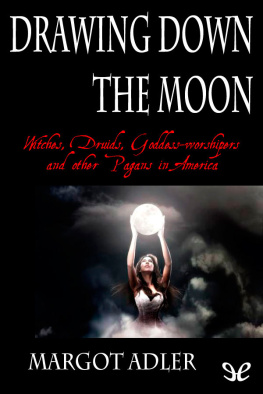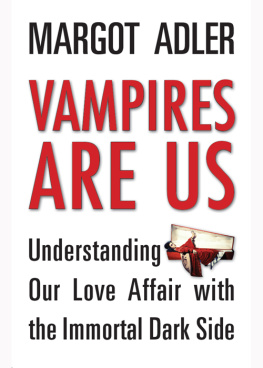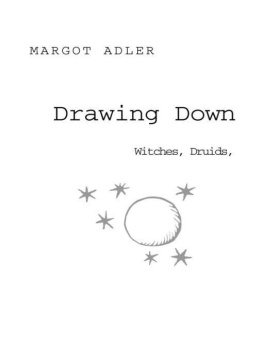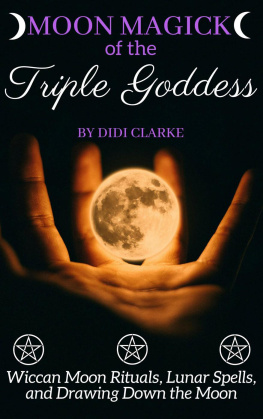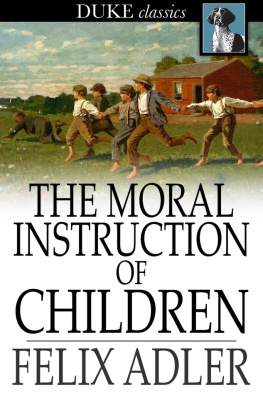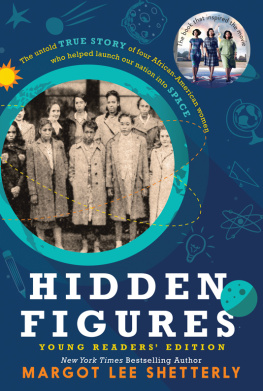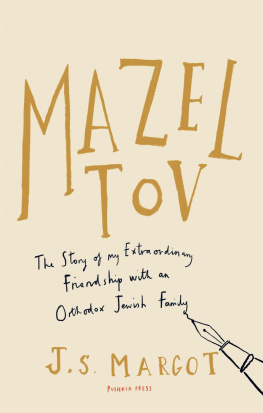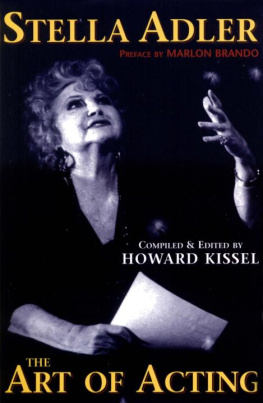Margot Adler - Drawing Down the Moon
Here you can read online Margot Adler - Drawing Down the Moon full text of the book (entire story) in english for free. Download pdf and epub, get meaning, cover and reviews about this ebook. year: 1979, publisher: ePubLibre, genre: Religion. Description of the work, (preface) as well as reviews are available. Best literature library LitArk.com created for fans of good reading and offers a wide selection of genres:
Romance novel
Science fiction
Adventure
Detective
Science
History
Home and family
Prose
Art
Politics
Computer
Non-fiction
Religion
Business
Children
Humor
Choose a favorite category and find really read worthwhile books. Enjoy immersion in the world of imagination, feel the emotions of the characters or learn something new for yourself, make an fascinating discovery.
- Book:Drawing Down the Moon
- Author:
- Publisher:ePubLibre
- Genre:
- Year:1979
- Rating:4 / 5
- Favourites:Add to favourites
- Your mark:
- 80
- 1
- 2
- 3
- 4
- 5
Drawing Down the Moon: summary, description and annotation
We offer to read an annotation, description, summary or preface (depends on what the author of the book "Drawing Down the Moon" wrote himself). If you haven't found the necessary information about the book — write in the comments, we will try to find it.
Margot Adler: author's other books
Who wrote Drawing Down the Moon? Find out the surname, the name of the author of the book and a list of all author's works by series.
Drawing Down the Moon — read online for free the complete book (whole text) full work
Below is the text of the book, divided by pages. System saving the place of the last page read, allows you to conveniently read the book "Drawing Down the Moon" online for free, without having to search again every time where you left off. Put a bookmark, and you can go to the page where you finished reading at any time.
Font size:
Interval:
Bookmark:

Almost thirty years since its original publication, Drawing Down the Moon continues to be the only detailed history of the burgeoning but still widely misunderstood Neo-Pagan subculture. Margot Adler attended ritual gatherings and interviewed a diverse, colorful gallery of people across the United States, people who find inspiration in ancient deities, nature, myth, even science fiction. In this new edition featuring an updated resource guide of newsletters, journals, books, groups, and festivals, Margot Adler takes a fascinating and honest look at the religious experiences, beliefs, and lifestyles of modern America's Pagan groups.

Margot Adler
Witches, Druids, Goddess-worshipers and other Pagans in America
ePub r1.0
Sharadore12.06.13
Original Title: Drawing Down the Moon: Witches, Druids, Goddess-worshipers and other Pagans in America
Margot Adler, October 1979 (1st Edition); revised 1986
Cover Design: Sharadore
Editor digital: Sharadore
ePub base r1.0
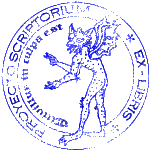

MARGOT ADLER. (Little Rock, Arkansas April 16, 1946). American author, journalist, lecturer, Wiccan priestess and radio journalist and correspondent for National Public Radio (NPR). She received a bachelor of arts in political science from the University of California, Berkeley, and a master's degree from the Columbia University Graduate School of Journalism in New York in 1970.
Since 9/11, she has focused much of her work on stories exploring the human factors in New York City, from the loss of loved ones, homes and jobs, to work in the relief effort. She was the host of Justice Talking up until the show ceased production on July 3, 2008. She is a regular voice on Morning Edition and All Things Considered. She is also co-producer of an award-winning radio drama, War Day.
Granddaughter of the Austrian Jewish psychotherapist, famous founder of the School of Individual Psychology, Alfred Adler, she is a Wiccan priestess in the Gardnerian tradition, an elder in the Covenant of the Goddess, and she also participates in the Unitarian Universalist faith community.

Drawing down the moon: one of the few known depictions of this ancient ritual, from a Greek vase probably of the second century b.c.e.
(New York Public Library)
On All Hallows Eve, 1979, Drawing Down the Moon was published in New York City. On the same day, Starhawks The Spiral Dance was published in California. These two books continue to be many peoples introduction to modern Paganism, Wicca, and Goddess spirituality. These books have different perspectives, but they both envisioned a Pagan movement much larger than the one that existed when the books were first published. That larger movement has come to pass, although it is different than either author dreamed or expected.
When Drawing Down the Moon was published, modern Pagans, Heathens, Druids, and Wiccans in the United States numbered less than one hundred thousand people. Today many estimates are four to seven times that number, with more than a million worldwide.
In the more than twenty-five years since Drawing Down the Moon was published, the world is much changed, but strangely, although many of the details have altered, and some of the early organizations no longer exist, the root ideas in Drawing Down the Moon seem more relevant now than they did in 1979.
The message of Drawing Down the Moon has always been that the spiritual world is like the natural worldonly diversity will save it. Just as the health of a forest or fragrant meadow can be measured by the number of different insects and plants and creatures that successfully make it their home, so only by an extraordinary abundance of disparate spiritual and philosophic paths will human beings navigate a pathway through the dark and swirling storms that mark our current era. Not by one avenue alone, wrote Symmachus sixteen centuries ago, can we arrive at so tremendous a secret.
The dominant spiritual trend of our time is militant fundamentalism. Suicide bombers die as martyrs in Palestine and Iraq. In this country, fundamentalists fight to change textbooks and ban books. Like corporations that reduce developing countries to poverty by turning all acreage to a single crop, the belief that there is one word, one truth, one path to the light, makes it easy to destroy ideas, institutions, and people. Almost a hundred years ago, the historian James Breasted wrote this controversial sentence worth contemplating: Monotheism is but imperialism in religion.
If you go far enough back, all our ancestors were Pagans. They practiced religions that had few creeds or dogmas. There were no prophets. There were myths and legends, but no scriptures to be taken literally. These religions were based on the celebration of the seasonal cycles of nature. They were based on what people did, not what people believed. It is these polytheistic religions that are being revived and re-created by Neo-Pagans today. This book is the story of that Pagan resurgence.
Drawing Down the Moon is grounded in the view that reality is multiple and diverse. It stands against the totalistic religious and political views that dominate the world. It says, strive to be comfortable in chaos and complexity. Be as a shaman who walks in many worlds. The books basic assumption is that your own spiritual path is not necessarily mine. In fact, even the most extreme and authoritarian religions can be seen as appropriate individual spiritual pathsbut they are only one flower in a garden.
Now, there are many anti-authoritarian religious groups, and many Christian, Muslim, and Jewish groups among them, not to mention Quakers, Bahais, Unitarians, and countless others. Whats unusual about modern Pagans is that they remain anti-authoritarian while retaining rituals and ecstatic techniques that, in our time, are used mostly by dogmatic religions or indigenous tribal groups.
Since Pagans are a very diverse group, it is wrong to say all Pagans believe this or that, but here are some beliefs that many people in this book share:
The world is holy. Nature is holy. The body is holy. Sexuality is holy. The imagination is holy. Divinity is immanent in nature; it is within you as well as without. Most spiritual paths ultimately lead people to the understanding of their own connection to the divine. While human beings are often cut off from experiencing the deep and ever-present connection between themselves and the universe, that connection can often be regained through ceremony and community. The energy you put out into the world comes back.
There are now many good books on modern Paganism, Witchcraft, and Goddess spirituality, and many important scholarly works. But this book is still the only detailed history of the origins of Neo-Paganism in the United States. So, in preparing this new edition, there was a constant tension between keeping the book as a piece of history and detailing the journey that modern Paganism has made over the last twenty years, the time thats passed since the last real revision of this book. Many people have asked me to only put in additions, not changes. In the end I have taken a middle course, the same one I took in 1986leaving most of the book intact, making some changes, cutting out some parts of chapters that seemed overly long (Living on the Earth), putting one chapter that seemed really outdated into an appendix (Scholars, Writers, Journalists, and the Occult), expanding greatly the sections on Pagan Festivals, Heathenism, Gay Spirituality, the Erisians, and Wiccan Traditions, and adding some new pages on Pagan studies. I also created a much larger up-to-date resource guide to Pagan groups, festivals, and publications and Web sites, more than three hundred listings, with many more Druid and Heathen groups, as well as more entries from Europe, Australia, Canada, and South Africa. Despite this, the explosion of Pagan festivals (more than 350 in the United States), Web sites (at least 5,000, probably more), and groups means that the Pagan movement is becoming so large it is much more difficult to chart.
Font size:
Interval:
Bookmark:
Similar books «Drawing Down the Moon»
Look at similar books to Drawing Down the Moon. We have selected literature similar in name and meaning in the hope of providing readers with more options to find new, interesting, not yet read works.
Discussion, reviews of the book Drawing Down the Moon and just readers' own opinions. Leave your comments, write what you think about the work, its meaning or the main characters. Specify what exactly you liked and what you didn't like, and why you think so.

